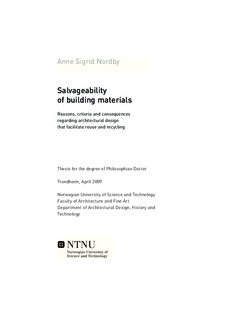| dc.contributor.author | Nordby, Anne Sigrid | nb_NO |
| dc.date.accessioned | 2014-12-19T11:23:15Z | |
| dc.date.available | 2014-12-19T11:23:15Z | |
| dc.date.created | 2009-05-12 | nb_NO |
| dc.date.issued | 2009 | nb_NO |
| dc.identifier | 225736 | nb_NO |
| dc.identifier.isbn | 978-82-471-1552-7 (printed ver.) | nb_NO |
| dc.identifier.isbn | 978-82-471-1553-4 (electronic ver.) | nb_NO |
| dc.identifier.uri | http://hdl.handle.net/11250/231092 | |
| dc.description.abstract | This thesis focuses on resource efficiency of building materials achieved through facilitating reuse and recycling of components. The overriding scope is to investigate building methods that may contribute to solving a set of environmental challenges in a long-term perspective, and to explore ways to expand the applicability and transfer the concept to contemporary architectural practice. The aim of the work is to contribute to new understanding in this field, both at the level of design, and at a more general level of the building trade where the drivers and the hurdles for environmental considerations are complex and interconnected. The thesis uses a multi-disciplinary approach and the investigations are carried out with a diversity of methods including quantitative and qualitative assessments, literature studies, case studies and discussions. The findings and reflections are seen as puzzle pieces that try to make the picture of life cycle design more complete.
The main work in the thesis is divided in three sections that make contributions to separate areas of inquiry, headed under the questions "WHY", "HOW" and "SO WHAT". These consist in total of five papers that build upon each other and that are written and presented in a chronological order.
The quantitative analysis in the paper discussing the question "WHY" aims at substantiating the environmental rationale for facilitating reuse and recycling. An introduction of the concept environmentally justifiableinitiates an exploration of the normative relationship between lifetime environmental impact and the number of functional lifetimes of components. A quantification of greenhouse gas-emissions related to extraction, production and transport of building materials is set as a point of departure for a calculation of expected lifetime, or "pay-back time" for ten exterior wall constructions. The comparative results reveal large differences in impact between the construction materials and subsequently large differences in the need for salvageability. The conclusion is that assessed environmental costs can complement forecasted turnover as a rationale for salvageable design. The calculation method that was used represents a quantifiable measure for expected building generations. This contribution may help enlarging the scope for salvageability.
The overriding question in "HOW" is how building design can facilitate future deconstruction and salvage of materials. First, existing research on Design for Disassembly (DfD) is analyzed, and a principal systematization of design guidelines is presented. The guidelines are divided into scale of application, main criteria and prescriptive strategies, and are structured in a matrix that may also be used as a tool for assessment. The aim is to create a consistent and multi-purpose base of information to be used in the rest of the work. Furthermore, as the term Design for Disassembly only reflects the disassembly phase, the term salvageability is suggested as a more adequate replacement.
Then two case-studies are performed. The first case-study assesses the reusability of massive wood component types and the second investigates brickwork constructions. The assessment matrix is used in both studies. Also, the background and the practical, technical and architectural consequences of the design measures for each criterion are explained and discussed. Both case-studies show that the examples of historical construction methods hold an overall high reusability, not only due to high scores for reversible connections but for all the criteria regarding salvageability. Furthermore, both studies show that there are great potentials to improve the reusability for the most commonly used constructions in massive wood and brickwork today. The assessment method itself is also commented upon.
The aim of "SO WHAT" is to discuss the architectural consequences of the design strategies. The overriding hypothesis is that the demand for salvageability of building materials may be seen as a positive driver for architectural design. As in the case-studies, the framework of the study is based upon the criteria for salvageability. The research investigates in what ways this field of knowledge may influence building practice and architectural expression, and points to building examples from past and present. The discussions verify the hypothesis, and show that some of the criteria may have great consequences for building design. The study furthermore explores the concept of tectonics and in what ways environmental logic can substantiate architectural articulation. The focus shifts from the restrictions that the demand for salvageability may pose upon construction, and rather point to the potential for creating meaningful architecture in a low-carbon society.
| nb_NO |
| dc.language | eng | nb_NO |
| dc.publisher | Norges teknisk-naturvitenskapelige universitet, Fakultet for arkitektur og billedkunst, Institutt for byggekunst, historie og teknologi | nb_NO |
| dc.relation.ispartofseries | Doktoravhandlinger ved NTNU, 1503-8181; 2009:87 | nb_NO |
| dc.title | Salvageability of building materials: Reasons, criteria and consequences regarding architectural design that facilitate reuse and recycling | nb_NO |
| dc.type | Doctoral thesis | nb_NO |
| dc.contributor.department | Norges teknisk-naturvitenskapelige universitet, Fakultet for arkitektur og billedkunst, Institutt for byggekunst, historie og teknologi | nb_NO |
| dc.description.degree | PhD i arkitektur | nb_NO |
| dc.description.degree | PhD in Architecture | en_GB |

